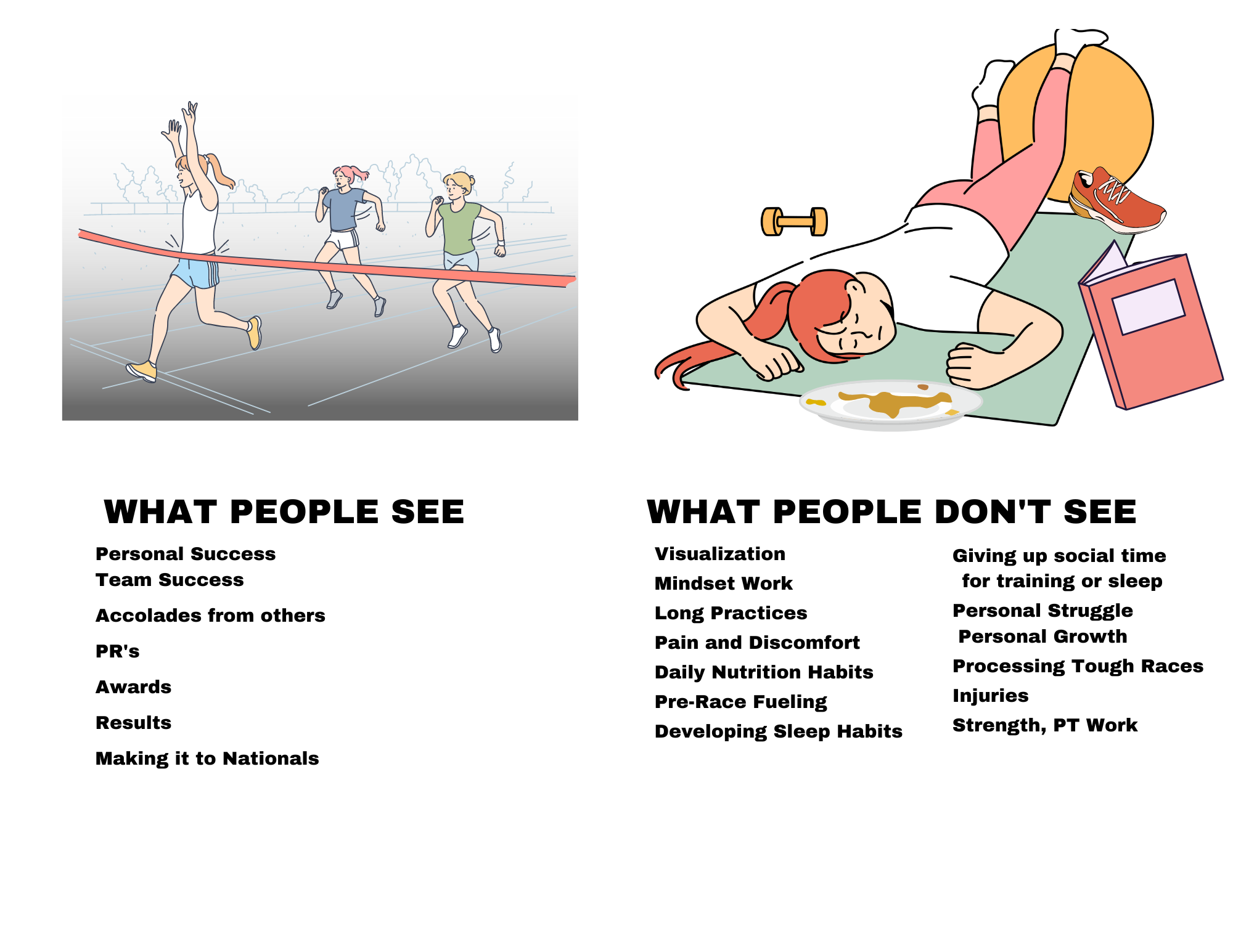Segment 3: Building Raceday Confidence
You believe your goal is possible. Let’s work on making that dream a reality.
Showing up to a race confident requires that you show up with one or more objectives to execute on. As discussed in Segment 1, objectives give us a mission and a focus on race-day so our thoughts don’t wander away from fulfilling our objectives. However, it takes practice to get to the start-line ready to accomplish an objective other than simply finishing the course. Confidence is achieved by tackling small barriers while slowly increasing the stakes and risk. If success happens when hard work meets opportunity, confidence happens when trust the hard work!
How you can avoid mentally disengaging during your races
How to shift away from a negative mindset
How to get to the start-line cool, calm, and collected
What is confidence and how do you build it?
How you can prepare yourself
Gathering course information
2 Tough Questions
How do you concentrate?
How do you become more confident?
Daily Practice!
Every season athletes are asked to set goals. Maybe you’ve been asked to use the S.M.A.R.T. Method, or write down three things you want to accomplish. These are good practices but rarely net results because the process of achieving these goals stops after writing them down or putting them down on a poster board. If you’re already going to think about a time or objective every time you lace up for a practice or a race - you might as well take the next step and own the whole process.
The HOW
I’ll be blunt. You won’t improve as quickly if you do the minimum of what’s asked of you. Dig in a little deeper - what needs to change for you to accomplish your goal? You will see the biggest shift in performance when you take ownership of the little things that make up the big things. Quite often, the daily practices go unsee. It seems like there is an understanding that if an athlete states a goal, and shows up for practice, the results will just happen because you participated. When you make personal growth a daily practice, you get better as a runner, student, friend, and person. Here are a few things to think about to create a daily practice.
What daily actions do you need to do daily to accomplish this goal?
Develop good eating habits, stretching, strength, PT, Sleep, etc.
Do I have everything I need to accomplish this goal?
PT, Facilities, Massage Tools, Shoes, Time
Who do I need to become to accomplish this goal?
Character Development, Mental Toughness
Asking for feedback on how to improve
Make a statement
“Without action, the best intentions in the world are nothing more than that: intentions.”
If you’ve made it this far - you’re invested in getting better. Now the hard work begins. Showing up, running the miles, and doing the workouts is just the start. Defining where you need to improve is a major step in building confidence, the final step is execution. Let’s go back to the top - you believe your goal is possible! You might think it’s silly but you must first start by making a state of what you will do, and how! Bring it all together now!
I am mentally tough! I’ll practice this on workout days by hanging in longer than I did last week.
I will start eating better before runs and races. I can develop a plan with my coach/parents/ nutritionist.
I am strong and I believe I can run XX: XX today. I will execute my plan.
I will do my PT every day, I’m tired of being injured.
I am capable of being a champion, I will do what it takes.
I want better running form, I will do my drills on my own after practice
I want to run faster, I am going to hit the gym 2x a week in the off-season
I am going to show up to the race confident. I will practice positive talk leading into the race!
Execute
Set aside a few minutes and review the statements you wrote down every day. It comes back to you to execute. Make time for what you need to achieve your goals and take it one step at a time. Sometimes really big goals have sub-goals along the way. Don’t forget to celebrate the little wins as you inch closer and closer!
Wait, so that’s the trick to confidence? Statements? - Seriously?
Go back up top - You believe it’s possible - now you have a framework to execute and stick to.
Visualization and Race Planning
This is a thick topic we will expand on in future segments. Visualization is a very powerful tool, and we’re going to cover the basics; just enough to get you started.
The Ideal Scenario
Take time to write out how the best version of you would feel in an ideal setting for a race. Envision it “going well”
Detail the ideal scenario - the bus ride, the snacks, the warm-up, the race, the cooldown
Be specific, how does the air feel? What can you taste? What does Mile 2 feel like?
Practice
Review this ideal scenario daily.
Sit with it and review it as you stretch. Envision your scenario - envision your success
As you get more comfortable with visualization, you can apply your ideal scenario to courses and races
Bonus: You will get sidetracked by negative thoughts, envision how the best version of you would tackle a fall, a pass, or a tough day
The Delta
Compare your behaviors in the “ideal” to how you currently operate and create I am, I will statements
When you encounter anxieties or fears, keep a list. It’s vital you also write how you will respond to a specific fear.
Planning and Execution
Take time to review your ideal scenario and visualize your success. This isn’t all about winning and PRs. It comes back to executing on the objectives you set for yourself in the upcoming race. Visualize your watch and see the time. Feel your feet in the grass. Taste your pre-race snack.
Make time on the bus or in the car on the way to the race - using headphones and closing your eyes is a great signal to others that you need a moment to sit with your thoughts.
When you follow through with a race day routine (we linked one below) it allows you to easily slip into a place of mental focus and execute on your objectives.
Eliminate as many distractions before you race as possible. If you came to do work, act like it!
Getting Stuck
If you get stuck, take time to investigate and lean into your sticking point. If you’re having trouble tracking down a solution - reach out to another athlete, coach, mentor, or parent. I’m sure there’s a creative solution to your problem you just haven’t thought of


